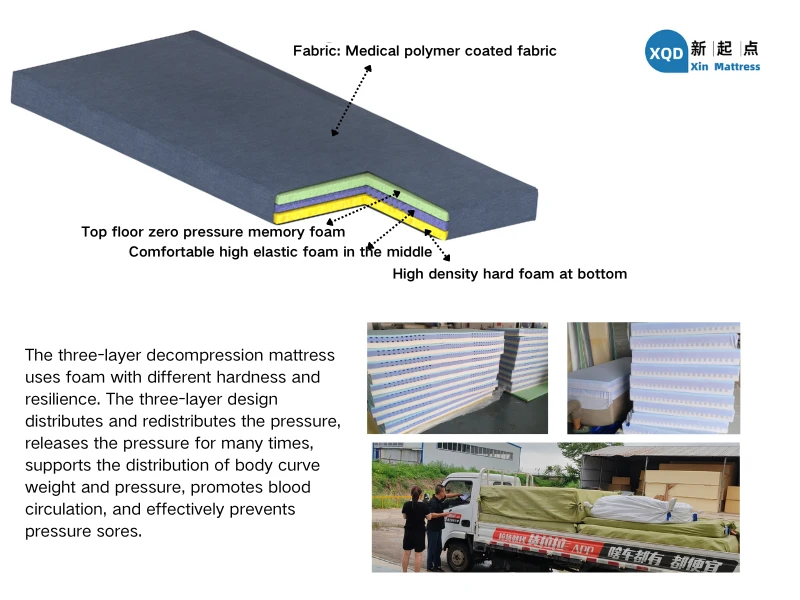High-Quality Mattresses Designed for Effective Bed Sore Prevention and Patient Comfort
The Importance of Specialized Mattresses for Bedsore Prevention
Bedsore, also known as pressure ulcers, is a common condition that affects individuals who are immobile or spend prolonged periods in bed. These painful sores can significantly impede recovery from illness, increase healthcare costs, and diminish the quality of life. To combat this issue, the mattress industry has made significant strides in developing specialized products aimed at preventing bedsores. This article explores the importance of these mattresses and how they contribute to better health outcomes.
Understanding Pressure Ulcers
Before delving into the solutions, it is essential to understand what causes pressure ulcers. When a person remains in one position for too long, the weight of their body exerts pressure on certain areas, particularly bony prominences such as heels, elbows, and the tailbone. This pressure can restrict blood flow, leading to tissue damage and eventually the formation of ulcers. Factors such as moisture, friction, and shear forces can exacerbate the problem. Thus, effective prevention is critical for at-risk individuals, such as those with limited mobility, the elderly, and patients recovering from surgery or serious health conditions.
The Role of Specialized Mattresses
Specialized mattresses for bedsore prevention are designed to reduce pressure on vulnerable areas, enhance blood circulation, and promote comfort. There are several types of these mattresses, each employing different technologies to achieve these goals.
1. Alternating Pressure Mattresses These mattresses feature a system that alternates inflation and deflation of air cells, redistributing pressure dynamically. The changes in pressure encourage blood flow to the affected areas, effectively reducing the risk of ulcer formation.
2. Foam Mattresses High-density foam mattresses are designed to contour to the body's natural shape, distributing weight evenly. Memory foam, in particular, is known for its pressure-relieving properties, making it an excellent choice for individuals who are at risk for bedsores.
mattress for bedsore prevention company

3. Gel Mattresses Gel-infused mattresses combine the benefits of airflow, cooling properties, and weight distribution. The gel layer helps to dissipate heat while providing a cushioned surface that minimizes pressure points.
4. Hybrid Designs Some mattresses combine different technologies, such as foam and air, to offer both comfort and pressure relief. These hybrid designs provide personalized support and are often adjustable, catering to individual needs.
The Importance of Choosing the Right Mattress
Selecting the appropriate mattress is crucial for effective bedsore prevention. Healthcare providers, caregivers, and family members should consider individual needs, weight, and mobility when making their choice. While many hospitals and long-term care facilities are equipped with specialized mattresses, at-home care also warrants consideration of these products.
Investing in a specialized mattress can reduce the incidence of bedsores significantly. It not only helps in faster recovery for patients but also minimizes the need for costly treatments associated with advanced-stage pressure ulcers, which can include surgeries and extended hospital stays.
Conclusion
In conclusion, the development of specialized mattresses for bedsore prevention is a vital component in the healthcare domain. By understanding the causes of pressure ulcers and utilizing the appropriate mattress technology, we can significantly mitigate the risk for vulnerable populations. As care standards continue to improve, the integration of these advanced products represents a crucial step toward enhancing patient comfort and promoting healing. For those who are at risk, a suitable mattress is not merely a product; it is a vital instrument in safeguarding their health and dignity. Investing in such technology is an investment in quality care and improved quality of life.
-
The Effect of Coconut Foam Mattress Breathability and Humidity Regulation on Improving Sleep QualityNewsJul.03,2025
-
How Wave Mattress Systems Improve Blood Circulation During ImmobilityNewsJul.03,2025
-
The Climate-Adaptive Sleep Revolution: Exploring the Benefits of Cooling Gel Memory Foam MattressesNewsJul.03,2025
-
Exploration of the Role of Coconut Foam Mattress in Preventing Bedsores in the ElderlyNewsJul.03,2025
-
Comparing Wave Mattress and Air Mattress: Which Is Better for Medical Use?NewsJul.03,2025
-
Analysis of Comfort and Environmental Performance of Natural Latex and Coconut Foam MattressNewsJul.03,2025
-
Multi-Layer Construction for Enhanced Performance in Gel Mattress PadNewsJun.24,2025

